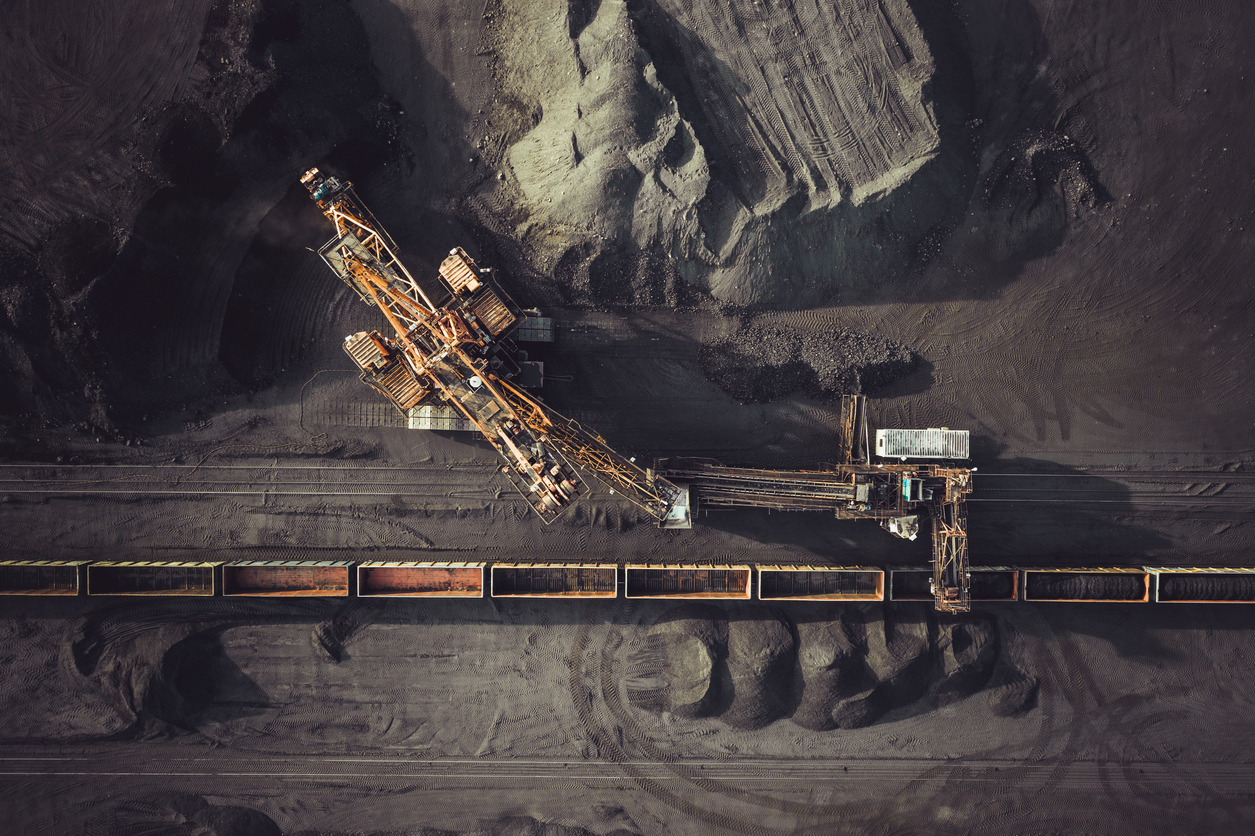
As the war in Ukraine continues, and sanctions against Russian business continue to expand, mining companies have been exiting businesses in the country. Rio Tinto (ASX:RIO), BHP (NYSE:BHP), and more have been selling assets in Russia as they mak their exit.
Canada’s Kinross Gold (NYSE:KGC) is the latest company to dump holdings there, selling the Kupol and Dvoinnoye operating mines; exploration assets, including the Chulbatkan project; and related infrastructure to Highland Gold Mining and other associates in a $680 million cash deal. Under the agreement, Kinross will receive $400 million in cash for the Kupol mine and surrounding exploration rights.
When the transaction closes, Kinross will receive $100 million, with another $150 million to be paid out before the end of 2023, an additional $100 million before the end of 2024, and a final payment of $50 million before the end of 2025.
Highland Gold CEO Vladislav Sviblov commented in a press release: “Our largest mining hubs are located in the Khabarovsk and Chukotka regions, precisely where these mines are located, and we, therefore, anticipate operational, logistical and management synergies. We also intend to maintain the high operating standards of the previous owner, and to invest in employee development.”
Deals in the country are tightly linked with government approval and oversight considering the stakes, and the Russian Federation Ministry of Industry and Trade, Denis Manturov, commented: “Kinross Gold followed the second of the three options proposed by the government for foreign investors with choosing a civilised way out of Russian projects. Therefore, we support the execution of such a deal: the result will be a stable flow of tax revenues, save of working places and support for social projects in the regions of presence.”
A Civilized Way Out
For mining companies with assets in Russia, the path out of the country has been swift. The largest mining companies in the world have all pulled out or are in the process of selling assets, and while the reasons behind it vary, sanctions and political risk are the primary drivers.
Kinross Gold is the latest company to sell its Russian assets, with the sale totaling $680 million, and many other companies are in discussions to exit their businesses in the country.
The European Union has likewise stated that in response to Russia’s invasion of Ukraine, the European Commission will impose a ban on Russian coal and other items. A potential EU ban on Russian coal import, according to a Reuters source, would be worth around €4bn per year.
The above references an opinion and is for information purposes only. It is not intended to be investment advice. Seek a licensed professional for investment advice. The author is not an insider or shareholder of any of the companies mentioned above.

Kinross (NYSE:KGC), the senior Canadian gold producer, announced in on February 24, 2022 the completion of the plan of arrangement to acquire all of the issued and outstanding shares of Great Bear Resources for C$1.8 billion. The company’s primary asset, the Dixie project, where drilling has revealed world-class structures, includes 9.14 ha of contiguous deposits extending over 22km and is one of the largest and most exciting discoveries in recent years.
J.Paul Rollinson, president and chief executive officer of Kinross said, “The closing of the acquisition of Great Bear Resources represents a milestone for Kinross as we advance our future growth strategy. We are excited to add such a high-quality asset in a top mining jurisdiction to our global portfolio.”
“The Dixie project represents an exciting opportunity to develop a potentially world-class deposit into a large, long-life mining complex.”
Trillium Gold’s Dominant Land Package
The massive deal underscores the importance and potential of the Red Lake Mining District, an area where Trillium Gold Mines (TSXV:TGM), a gold exploration company with a dominant land package in the area is operating.
Along the same structural trend as the Dixie deposit, Trillium Gold recently announced a definitive agreement to acquire a massive contiguous land package over a major part of the Confederation Belt that covers more than 100 km of structure. Trillium’s land package is not only on-trend, but is the largest land assemblage in the area. Considering the size and potential of the Confederation Belt land package, the potential for multiple Dixie-size discoveries is within the company’s midst. The definitive agreement is seen as an important step in strengthening the Company’s strategic advantage to consolidate the greenstone belt and position it as the most dominant exploration company in the Red Lake Mining District.
In January 2022, the Company reported results from 17 SGH (spaciotemporal geochemical hydrocarbon) regional soil sampling grids on its Confederation belt properties which identified numerous gold pathfinder anomalies that will serve as priority targets for Trillium Gold’s second phase of exploration work in the 2022 field season. The newly identified relationships among SGH-generated gold targets, historical gold assays and possible structural and lithological controls, effectively launch Trillium Gold’s Confederation belt properties into a new era in gold exploration.
The Willis Property
In addition, Trillium recently acquired a key land package southwest of its 100% owned Newman Todd Complex, a project initially being advanced towards open-pit mining, with depth potential to the southwest known as the Willis Property, comprising thirteen patented mineral licenses totalling 229 hectares.
As with the Newman Todd Property to the north, Willis shows many similarities to the major eastern gold mines: namely, rock types, structures, mineralization and alteration. Despite these attributes, the property has seen very little exploration since the 1930s and is one of the few remaining unexplored properties in the Red Lake greenstone belt.
As Trillium Gold continues to settle into its position as the most dominant exploration company in Red Lake, investors will continue to watch closely for the high potential at its Red Lake property portfolio the company has amassed over the past 12 months.
The above references an opinion and is for information purposes only. It is not intended to be investment advice. Seek a licensed professional for investment advice. The author is not an insider or shareholder of any of the companies mentioned above.
Q4 production challenges have meant Kinross investors missed out on recent strength in gold mining equities. Kinross (TSX:K) (NYSE:KGC) has underperformed the Gold Miners ETF (GDX) by ~15% YTD.
Geopolitics and sanctions may also be near-term headwinds given that Russian operations accounted for 20% of 2021 production. However, 2022 performance is more likely to be driven by their ability to deliver on broader production and capital strategies.
Production interruptions in Q4
Earlier this month, Kinross announced it would book a Q4 loss of $2.7 million due to interruptions which decreased production by 22% compared to Q4 2021. Adjusted Q4 net earnings were $101.8 million, or $0.08 per share, compared with $335.1 million or $0.27 per share for Q4 2020.
The decrease was due to the suspension of operations after a mill fire at the Tasiast mine in Mauritania as well as deferred activity at Round Mountain, Nevada, where wall instability was detected in Q1 2021. Earnings were also hit by a non-cash write-down of $106.1 million from a reduced estimate of recoverable ounces at Bald Mountain, Nevada.
Results included some positive points such as returning $250 million in capital to shareholders and finalizing an agreement with the government of Mauritania regarding licenses near the Tasiast operation. The updated development outlook was also positive with a net reserve increase of 2.7 million oz. In the latest earnings call, CEO Paul Rollinson gave an average annual production estimate of at least 2.5 million oz over the rest of the decade.
While depressed production will persist into 2022, stronger numbers are expected in the latter half of the year. Annual production estimates were lowered slightly to 2.65 and 2.8 million GEOs for 2022 and 2023, respectively. (Previous estimates were 2.7 and 2.9 million.)

Turning the corner on capital allocation challenges
Some analysts have pointed to Kinross’ capital allocation challenges, including share dilution to finance expensive acquisitions in the post-2008 gold bull market, followed by impairment charges and underperforming assets.
Capital allocation concerns were echoed following the recent $1.42 billion acquisition of Great Bear Resources Ltd. The market punished Kinross in December of last year for what many felt was an expensive bid for Great Bear’s Dixie project, an exploration stage asset that had no resource estimate.
While it remains to be seen whether $1.42 billion was a good investment, other aspects of the capital allocation strategy (such as paying off debt and returning capital to shareholders) could be gauged in the nearer-term. Kinross repaid $500 million of senior debt in 2021 and maintains a low debt-to-equity ratio of 0.21. The company also returned $250 million to shareholders in 2021 through $150 million in dividends and $100 million in buybacks.
The longer-term success of Kinross’ capital allocation strategy will depend on their ability to maintain these trends which, in turn, would require strong sustained cash flows from production and gold prices. To appease the market on the expansion side of the strategy, the Dixie project would need a resource estimate of at least 7-8 million oz.
Russian operations and sanctions
About 20% of 2021 production came from the Kupol mine in Russia. The company issued a statement in response to the February 22 sanctions, maintaining that operations were unaffected. Whether this holds in light of developing events, remains to be seen.
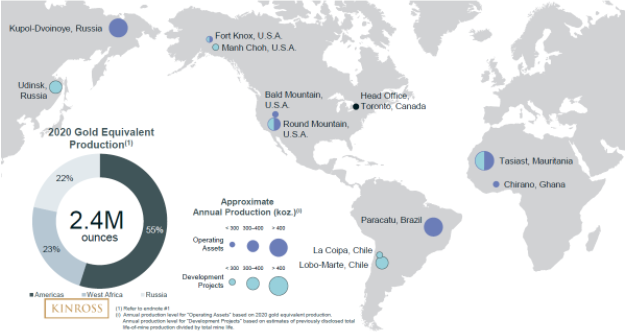
Source: kinross.com
In response to a question in the Q4 earnings call, CEO Paul Rollinson highlighted their 25 year operating success in Russia, as well as the fact that 98% of site employees are Russian and mine supplies are procured regionally. Even if supply chains were disrupted, the remote site is stocked to operate well into 2022.
Rollinson also pointed out that Kinross operations were not affected by sanctions after the 2014 Crimea crisis. In fact, the subsequent decline in the ruble enhanced margins. Moreover, it is expected that Kupol will account for a lower percentage of total production (13%) in 2022 as they transition to mining narrower veins.
Basis for improved equity performance
The silver lining of Kinross’ recent underperformance is a relatively cheap equity price with strong fundamentals. Their relatively favourable ESG rankings could also be a positive should institutional capital reenter the sector.
For 2022, investors will be looking for a return to forecasted production together with a resource estimate indicating Dixie was a good investment.
The above references an opinion and is for information purposes only. It is not intended to be investment advice. Seek a licensed professional for investment advice. The author is an insider or shareholder of one or more of the companies mentioned above.
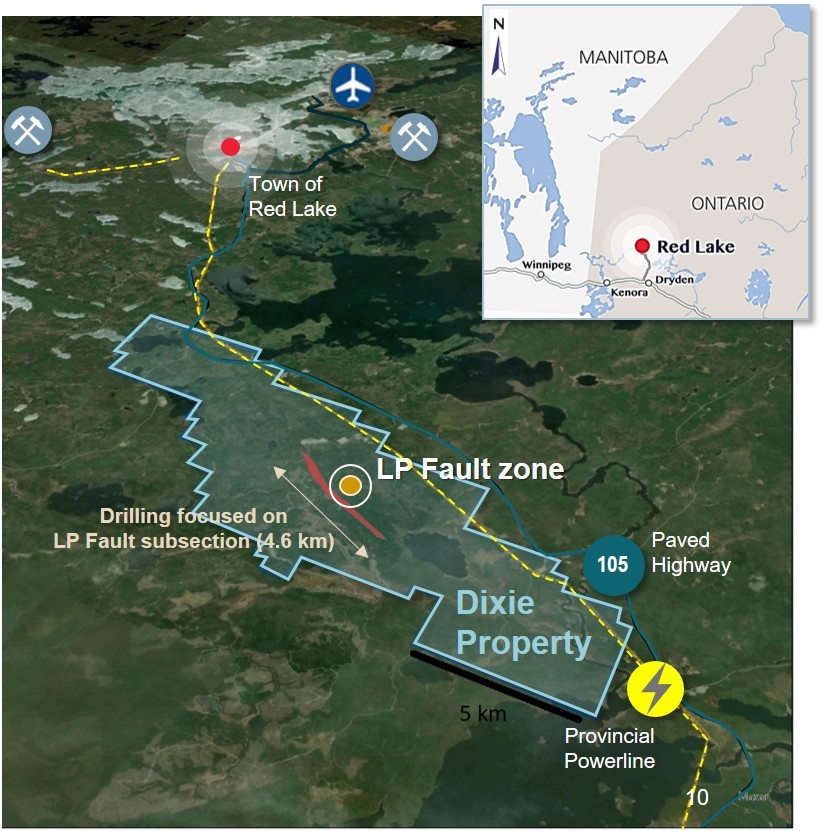
Canadian-based mining company Kinross Gold Corp. (NYSE:KGC) announced plans to acquire Great Bear Resources Ltd. for an upfront payment of $1.8 billion, a huge acquisition in the Red Lake Mining District in Ontario, Canada.
Kinross’s main focus in acquiring Great Bear is their Dixie project located in Red Lake. The project is said to have shown exciting recent gold discoveries and characteristics of a top-tier deposit.
Paul Rollinson, Kinross’ President, and CEO, said in a press release regarding the acquisition: “The Dixie project represents an exciting opportunity to develop a potentially top-tier deposit into a large, long-life mine complex. In addition to the prospect of developing a quality, high-grade open pit mine, we also believe that a significant portion of the asset’s value is its longer-term potential, which includes the view of a sizable underground operation.”
Great Bear is a junior gold mining company, and purchased the Red lake property from Newmont Mining back in 2017. Within the four years of owning the Dixie project, the Vancouver-based company has made outstanding discoveries. To date, Great Bear has completed more than 340,000 metres of drilling in 794 drill holes and has identified five high-grade gold discoveries.
Chris Taylor, Great Bear’s president and CEO said: “Kinross first set foot on the Dixie property three years ago, and has closely monitored the discovery and growth of each successive gold discovery Great Bear has made. With extensive drilling now completed at Dixie, both companies have a shared vision of the clear potential for a multi-deposit mine complex consisting of a potential high-grade open-pit mine and a long-life underground mine. As Great Bear’s track record of continuous discovery shows, the Dixie project hosts a prolific gold system that remains completely unconstrained and open to extension. In the near-term, with over 80% of the property unexplored, our shareholders will continue to have exposure to ongoing advanced project development and extensive exploration upside in the lead-up to planned production.”
The Dixie project is 91 square kilometres of contiguous claims and 25 kms southeast of the town of Red Lake. Only 20% of the property has actually been explored, which leaves high potential for many more high-grade discoveries. Some analysts speculate that the property could contain up to 20 million ounces of gold, which would raise its status to one of the largest gold mines in Canada.
Kinross President J. Paul Rollinson commented, “the Dixie project has multiple high-potential mineralized zones which remain open along strike and at depth, and we are confident that the asset has strong untapped upside with numerous avenues for growth.”
The most well-known and significant discovery at Dixie is known as the “LP Fault” zone. This area has continuous wide, moderate grade mineralization along with subparallel high-grade gold lenses which forms a 200 to 400 metre wide envelope of stacked zones. Drilling in the LP Fault zone concluded there is gold mineralization down to a depth of 786 metres along 10.8 kilometres of strike. The LP Fault zone also is said to have similar geological features to the Hemlo deposit, which has been a successful operation for more than 30 years.
200,000 metres of drilling is planned for 2022 for the LP Fault zone, with expected long-term potential and value.
Red Lake is also home to multiple Indigenous communities, the Wabauskang and Lac Seul First Nations, in which Great Bear and Kinross recognize the important territorial claims they have within the area.
The company has already had a meeting with the chiefs of both First Nations and looks forward to maintaining and growing their relationships with both Indigenous communities. The company is committed to ensuring its operations leave a positive and lasting legacy, and that they develop the area in a way that honours Indigenous rights and brings long-term socio-economic benefits to the region.
Not only is Kinross dedicated to respecting the importance of the Indigenous community, they also have a goal of being a net-zero greenhouse gases emissions company by 2050. Dixie is located in a low carbon energy grid which supports this goal. Kinross is planning to incorporate energy-efficient initiatives as it develops the Dixie project, including evaluating electric and hydrogen fuel fleets.
The project is also located in an established mining camp, making skilled labour and infrastructure easily accessible resources. Dixie also offers the potential for long-term tax benefits.
“We are pleased to achieve our goal of adding a high-quality asset in our home jurisdiction that further bolsters our global portfolio and can potentially provide long-term tax benefits,” said Kinross’ Rollinson. The deal is likely to close in the first quarter of 2022.
The above references an opinion and is for information purposes only. It is not intended to be investment advice. Seek a licensed professional for investment advice. The author is not an insider or shareholder of any of the companies mentioned above.
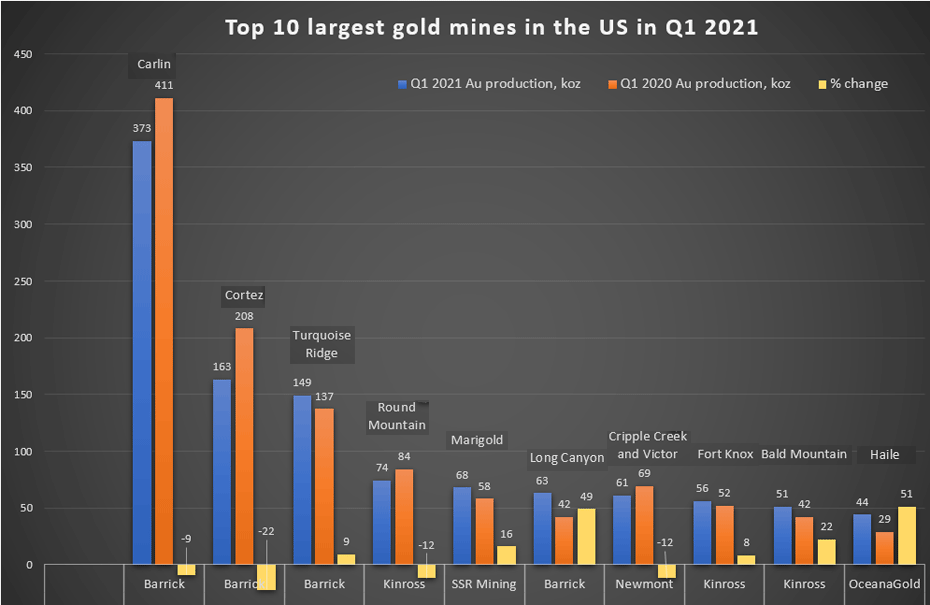
While serious concerns linger in the markets about the strength of the swing up, gold mining stocks have continued their leg higher. The first quarter of 2021 was a positive period for gold miners, creating a new extended rally to bring most back to pre-pandemic levels. While most of the biggest miners have been doing well, a drop in the gold stock benchmark and trading vehicle GDX VanEck Vectors Gold Miners ETF of 9.8% in Q1 demonstrates a lack of equality in the gains.
Sentiment Uncertainty Turns to Directional Confidence
Gold itself lost 10% through the period, but has rebounded quickly in Q2. This has been a big boost to miners, particularly in the US. It has been the majors that propped up the GDX in Q1; these stocks often amplify gold’s material moves by two or three times. As spot gold continues to recover, so does sentiment for gold miners, and the majors are seeing this more than others. The GDX reverted 21.8% higher in May, and continued to climb this month. During the same time, gold prices climbed 6.6%, with all indicators pointing to a better sentiment around gold and gold mining stocks.
Q1 2021 reported results show that the majors in particular are outperforming all other gold miners, with strong results and a growing share of the dominant gold-stock ETF. The top 25 GDX gold miners now account for 88.1% of the market cap of the ETF. This dominance is also borne out in the results, with almost all of the top gold mines by production and expansion in the U.S. being owned and operated by those same companies.
The top 25 stocks in the GDX reported recovering and powerful production numbers for Q1. Although total production dropped 2.8% in the period, total revenues jumped 10.5% YoY to $13.7B. This is one of the best quarters ever for this group.
Higher Commodity Prices Boosting Everything
The lower output was offset by 13.4% higher gold prices in the same period, boosting their bottom lines and pushing their financials along healthily. This has been a recurring trend in the mining industry as commodity prices continue to push higher every month with reopenings driving demand along and a positive outlook for the industry expands with every new project and restart announced. Production is nearing pre-pandemic levels again and investment in the first quarter picked up rapidly as miners raced to get back on track for 2021.
The bottom lines of the major gold miners in the ETF was impressive, with 47.1% high YoY earnings. Those soaring earnings and profits seem to be in line with a recovering industry and one that is moving faster than many other parts of the global economy. While some have tried to attribute this to low comparison from 2020, looking at most of these companies shows that this performance comes on the back of normal performance and not any over-compensation from the slowdown of last year.
The List of Winners
Kitco has put together a list of the top largest gold mines in the US based on gold production in Q1 2021, and it is clear that the biggest players continue to dominate not just the biggest gold stock ETF, but also production quantities.
Barrick takes four of the top ten spots, including the three top spots that seem to generally be reserved for the company across its Carlin, Cortez, and Turquoise Ridge mines. The biggest miners in the industry continue to dominate production and profits right now, but they are also lifting other stocks with them as gold prices rise and industry sentiment begins to reverse in Q2 2021.
| Operation | Major Owner/Operator | Q1 2021 Au production, koz | Q1 2020 Au production, koz | % Change | |
| 1 | Carlin | Barrick | 373 | 411 | -9 |
| 2 | Cortez | Barrick | 163 | 208 | -22 |
| 3 | Turquoise Ridge | Barick | 149 | 137 | 9 |
| 4 | Round Mountain | Kinross | 74 | 84 | -12 |
| 5 | Marigold | SSR Mining | 68 | 58 | 16 |
| 6 | Long Canyon | Barrick | 63 | 42 | 49 |
| 7 | Cripple Creek and Victor | Newmont | 61 | 69 | -12 |
| 8 | Fort Knox | Kinross | 56 | 52 | 8 |
| 9 | Bald Mountain | Kinross | 51 | 42 | 22 |
| 10 | Haile | OceanaGold | 44 | 29 | 51 |
Source: Kitco
The above references an opinion and is for information purposes only. It is not intended to be investment advice. Seek a licensed professional for investment advice. The author is not an insider or shareholder of any of the companies mentioned above.

Companies engaged in exploration, mining, and trading often have good returns and revenues. The past year has seen the VanEck Vectors Gold Miners ETF (GDX) underperform the broad market in the last 12 months, but the 11.8% return was more than solid. It is only against the backdrop of a 46.2% gain for the iShares Russell 1000 ETF or the S&P 500 that comparisons lose steam.
Mining for Gold Value
Gold mining companies within gold indexes, however, have been generating asymmetric returns. Many of the winners have continued to scoop up the gains of a rising gold price and a favorable market. Today we’ll take a look at those stocks which may be undervalued according to it’s P/E for June 2021.
Stock picking is often thought of as the reserve of people who have a special talent or gift, however, value investing is as simple as figuring out whether a business’s stock is cheap compared to its intrinsic value as measured by its price-to-earnings ratio. Taking a look at the 12-month trailing P/E ratio, the best value gold stocks are Centerra Gold Inc. (TSX:CG) (NYSE:CGAU), Jaguar Mining Inc. (JAG.TO), Torex Gold Resources Inc. (TSX:TXG), Karora Resources Inc. (TSX:KRR)), and Kinross Gold Corp. (TSX:K)).
Centerra Gold (TSX:CG) (NYSE:CGAU)
The Canadian gold mining and exploration company operates three mines at the moment producing 824,059 ounces of gold and 82.8 million pounds of copper in 2020 alone. The company ran into a speed bump at its Kumtor Mine in the Kyrgyz Republic when the Kyrgyz Government took control of the mine in mid-May. The company lost control of the mine and suspended previously issued guidance for 2021 due to the uncertainty of the situation. However, with a 12-month trailing P/E ratio of 4.1, the company could be a value play for some portfolios.
Jaguar Mining Inc. (TSX:JAG) (OTC:JAGGF)
Our second Canuck on the list explores and develops gold properties in the Iron Quadrangle in Brazil, a profitable greenstone belt in Minas Gerais, Brazil. With a 12-month trailing P/E of 5.4, Jaguar (TSX:JAG) (OTC:JAGGF) is a technical value play for a company operating in an area of mineral exploration dating back to the 16th century.
Torex Gold Resources (TSX:TXG) (OTC:TORXF)
Torex’s 100% owned Morelos Gold Property comprising 29,000 hectares in the Guerrero Gold Belt in Mexico is the flagship project for the company, in a portfolio that includes two other major mines in Mexico. The company’s P/E of 6.7 may be an indicator of an undervalued company waiting for the right attention from investors.
Karora Resources Inc. (TSX:KRR) (OTC:KRRGF)
Both of the company’s primary gold-producing operations are located in Australia along the Norseman-Wiluna Greenstone Belt. Net earnings for Q1 2021 came in at more than ten times YoY as revenue grew 9.2%. The company’s P/E of 6.7 could be an indication of a value play waiting to be unlocked with the kind of financial results from the first quarter of this year.
Kinross Gold Corp. (TSX:K) (NYSE:KGC)
With a diverse portfolio spanning Brazil, Chile, Ghana, Mauritania, and Russia, and forward guidance of 2.4 million gold equivalent ounces for 2021, Kinross (TSX:K) (NYSE:KGC). Net earnings rose 21% as revenues grew 12.1%, possibly making the company’s P/E of 6.8 a value indicator for 2021.
Hunting for Deals
Undervalued companies can be opportunities to pick up shares at bargain prices before the rest of the market figures it out. Stocks like Centerra Gold (TSX:CG) (NYSE:CGAU), Jaguar Mining Inc. (TSX:JAG) (OTC:JAGGF), Torex Gold Resource (TSX:TXG) (OTC:TORXF), Karora Resources Inc. (TSX:KRR) (OTC:KRRGF), and Kinross Gold Corp. (TSX:K) (NYSE:KGC) could be the value buys for 2021 for investors looking to add some gold stocks to their portfolios.
The above references an opinion and is for information purposes only. It is not intended to be investment advice. Seek a licensed professional for investment advice. The author is not an insider or shareholder of any of the companies mentioned above.
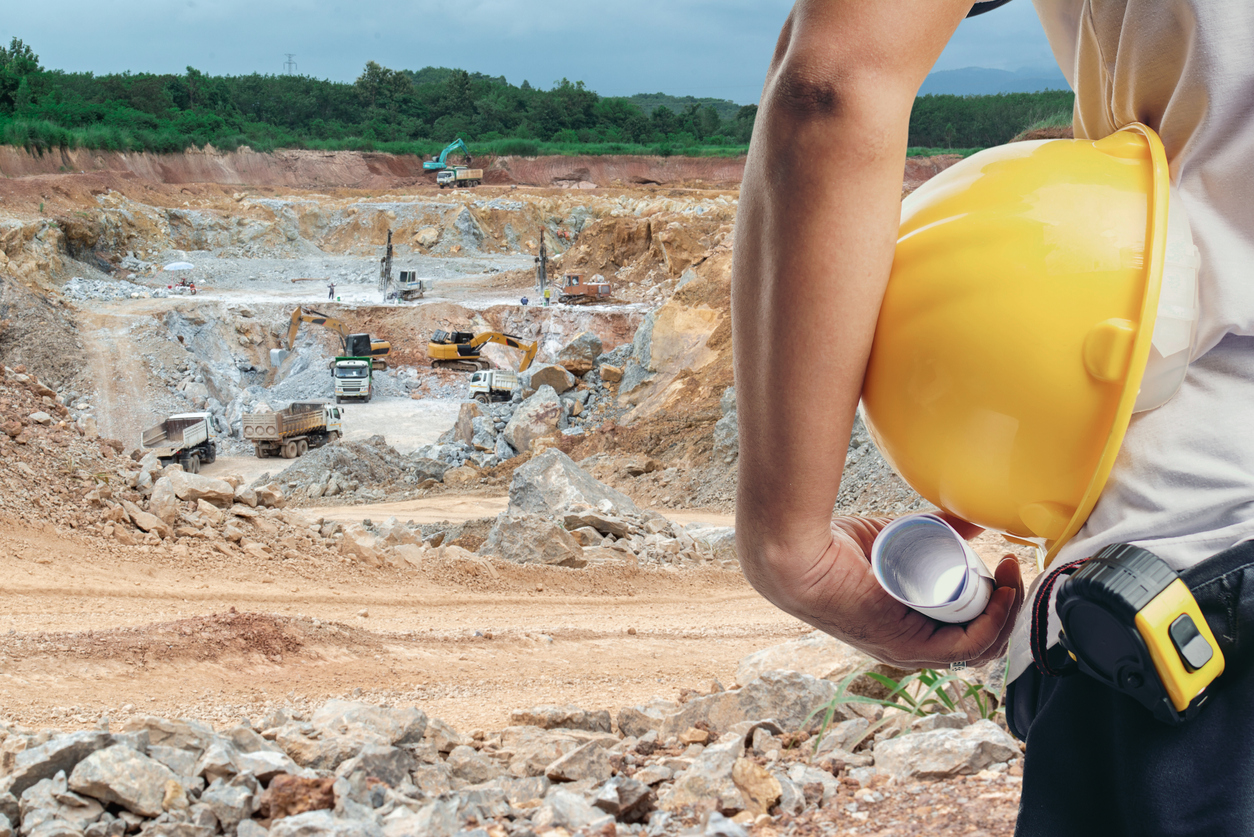

Mining companies are some of the biggest and most productive economic machines in the world. Mining produces important minerals and metals that are essential to the smooth functioning of society. Without mining, there would be no technology, no buildings, no electricity, and no global economy. For most, mining brings to mind some misconceptions about the industry and how it operates. It’s time to explore some of the positive effects of mining and get into the transformatively powerful effects of responsible mining around the world.
Kinross (NYSE:KGC) (TSX:K) Harvests Water From Snow in Chile
The Maricunga and La Coipa mines, located in the Atacama Desert approximately 4,000 metres above sea level, are some of the driest places on earth. Like everywhere else, water is critical to the ecosystems and wetlands that play host to wildlife including vicuna, flamingo, and guanaco. To ensure those habitats can thrive, Kinross Gold Corporation has implemented measures to improve the area’s water efficiency.
In 2011, the company installed 100-metre lines of wooden snow fencing. The fencing’s goal is to ensure that snowmelt infiltration into the groundwater is more efficient. This is helping to bring meaningful contribution to the local water supply. On top of that, Kinross and the Chilean National Irrigation Commission are exploring a joint research project. The project will investigate and test the snow harvesting tactic for potential use in other water-stress areas of Chile. The mining company is contributing resources and people to the job, and making a serious contribution to the country and the regions they operate in beyond the jobs and economic stimulus that their projects create.
Golden Star Resources (TSX:GSC) Builds a Health Centre
Golden Star Resources (TSX:GSC) has been a busy member of the Ghanaian community, particularly when it comes to healthcare. The company provides National Health Insurance Scheme coverage for every single employee as well as their immediate families. Golden Star was the winner of the PDAC 2018 Environmental and Social Responsibility Award, so it may come as no surprise that the company goes far beyond what is asked. The company has upgraded local clinic to provide services to all of its employees, and even built a health centre at Nsadweso, an Outpatients Department at the Prestea Government Hospital, nurses quarters at Bogoso, a mini-clinic at Brakwaline, and a community health post a Bondaye.
On top of all of the health infrastructure development Golden Star Resources (TSX:GSC) is doing, the company is also a supporter of Project C.U.R.E.. The project has delivered 29 containers of medical equipment, serving over 18 million people since 2003. Golden Star is a great example of how healthcare and wellbeing are integral to positive contributions for stakeholder communities and a company’s employees.
Solaris Resources (TSX:SLS) Flies in To Save a Child
Mining companies often need to operate in remote locations, where they are usually responsible for building and maintaining infrastructure and other services. Companies can be a powerful partner in these areas. Solaris Resources (TSX:SLS), a copper mining company with significant operations at its flagship Warintza Project in Ecuador, was exactly the kind of community partner needed in times of trouble for one 10-year-old patient.
When a child became ill and needed an emergency evacuation to a hospital in the border community of Banderas, near Peru, Solaris allowed for the air transfer of that child immediately and helped coordinate the rest of the transfer once the helicopter landed at Edmundo Carvajal airport in Macas. Since the location was so difficult to access, a helicopter was the only option, and Solaris (TSX:SLS) was able to coordinate the transport quickly, demonstrating that a powerful community partner from the mining industry could make a major difference in the lives of all stakeholders.
A statement from the Integrated Security Service and Lenin Moreno, Ecuadorian president at the time, read, “The work coordinated between security forces, citizens, and private enterprise made it possible to provide assistance at the right moment.”
Miners Continue to Be Strong Allies
While it may not always be obvious what private industry and communities can accomplish together, the results are clear. When government, citizens, and private enterprises in the mining industry come together for a common purpose, the industry is able to consistently demonstrate its ability to step up to the plate and hit home runs.
The above references an opinion and is for information purposes only. It is not intended to be investment advice. Seek a licensed professional for investment advice. The author is not an insider or shareholder of any of the companies mentioned above.


Gold giant Kinross Gold (TSX:K) announced financial results last month for its fourth-quarter and year-end 2020. Investors are pleased with the company’s net earnings of $783.3 million (62 cents a share) in 2020. The Toronto-based company nearly doubled its net adjusted earnings in 4Q2020 with a boost from higher gold prices to $335.1 million (27 cents a share), compared with $156 million (13 cents a share) in 4Q2019.
Tough Times
Kinross was able to capitalize on a strong gold price despite 2020 being a unique and challenging year for everyone in the industry. In the middle of one of the most challenging years for the mining industry, Kinross had a free cash flow of more than $1 billion.
While balancing the restrictions and complications in operations, the company still met its original guidance for the ninth consecutive year and was able to declare a quarterly dividend of 3 cents per share for 4Q. While the company saw lower production for the quarter with 624,032 ounces down from 645,344 ounces in the 2019 quarter, the results were not hit significantly and investors responded well to the news. 2020 production hit nearly 2.37 million attributable gold equivalent ounces compared with 205 million ounces in 2019. The company has excelled at maximizing operations and surpassing guidance even with consistently lower production in 2020.
Strong COVID-19 Risk Management
Management clearly has its eye on the ball and implemented operational and financial support to manage COVID-19 risks. The company implemented “…rigorous measures to keep our employees safe, maintain business continuity and support local communities,” Kinross President and Chief Executive Officer J. Paul Rollinson said in the earnings teleconference. He went on to thank employees worldwide for meeting the challenges.
With strong leadership during the challenging year, Kinross put together a comprehensive and efficient plan for managing the risks of the pandemic while continuing to maintain productivity and earnings. The company provided roughly $6 million in 2020 toward community efforts geared toward combating COVID-19 in areas where they operate mines. Some of the loss in revenues was a result of the extra costs and investments related to operations during the pandemic, but being able to balance those costs with successful mining operations puts Kinross in the lead for the industry for 2020.
A Bright 2021
The company made it clear that they are looking ahead to 2021 and beyond with optimism and forward-thinking production plans. In its exploration update, the company planned to spend $6.5 million on Bald Mountain Mine for exploration. The company will focus on drill testing targets identified in 2020 to look for deposits that may be converted to mineral resources later, turning some of the seeded work from last year into gains for the company in 2021.
$6 million in additional funds set aside for exploration at Round Mountain Mine, the first gold ounces produced at the Gilmore Project in January of this year, completed construction on the project on time and on budget, and spending of $120 million for all projects in 2021 is sure to build on last year’s performance.
A Pass With Flying Colours
The stock trades at $8.38 as of writing and has climbed steadily over the last 12 months. While the gains have been attractive, it is the consistent dividend and profitable performance of the company that still makes this an attractive investment. With even bigger plans for the company looking ahead to the bright side of 2021, Kinross Gold has its finger on the pulse of the operations and is in fantastic health.
If you would like to receive our free newsletter via email, simply enter your email address below & click subscribe.
CONNECT WITH US
Tweets
Tweet with hash tag #miningfeeds or @miningfeeds and your tweets will be displayed across this site.
MOST ACTIVE MINING STOCKS
Daily Gainers
        |
RTG.TO | +60.00% |
    |
ERL.AX | +50.00% |
    |
MRQ.AX | +50.00% |
        |
AFR.V | +33.33% |
    |
CRB.AX | +33.33% |
        |
GCX.V | +33.33% |
        |
RUG.V | +33.33% |
        |
CASA.V | +30.00% |
        |
BSK.V | +25.00% |
        |
PGC.V | +25.00% |
Articles
FOUND POSTS
Arras Minerals (TSXV:ARK) Updates on Elemes Drill Program in Kazakhstan
December 19, 2024
Potential Trump Tariffs Could Reshape Copper Market Dynamics in 2025
December 17, 2024












